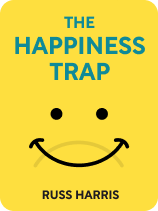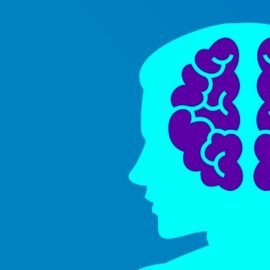

This article is an excerpt from the Shortform book guide to "The Happiness Trap" by Russ Harris. Shortform has the world's best summaries and analyses of books you should be reading.
Like this article? Sign up for a free trial here .
Is your mind overwhelmed by negativity? Do you often find yourself slipping into the vicious cycle of negative thinking?
People don’t choose to get stuck in cycles of negative thinking—they’ve simply developed unproductive strategies of processing negative thoughts. There are two types of strategies that can turn into a vicious cycle of negative thinking: fight strategies and flights strategies.
Keep reading for examples of each strategy.
Fight Strategies
- Suppression: You attempt to suppress your negative feelings by pushing them away. For instance, if you think, “I’m not good enough,” you may try to bury this thought instead of acknowledging it. (Shortform note: Suppression is a common strategy among people with obsessive-compulsive disorder (OCD), because they deal with frequent negative thoughts. However, this response often backfires, causing the suppressed thoughts to return in a “rebound” effect and leading to a vicious cycle of suppression and rebounding.)
- Arguing: You try to debate with yourself about your negative feelings. For instance, you may think, “I’m unhappy,” then argue with that feeling by thinking, “I shouldn’t be unhappy—look at all the things I have to be grateful for.” (Shortform note: While arguing against your negative thoughts may be fruitless, Byron Katie contends in The Work that you can weaken their power questioning their validity. When you have a negative thought, she suggests you reflect on whether it’s true, whether you can know that it’s true, how you react when you believe that it’s true, and who you would be if you didn’t believe it.)
- Taking Control: You try to assert control of your feelings in response to negative thoughts. For example, you may think, “I feel bad about myself,” then tell yourself to “toughen up” or “have thicker skin.”
- Self-Bullying: You beat yourself up about your negative thoughts and feelings. For instance, you may think, “I wish I were smarter,” then call yourself stupid for thinking you’re not smart enough as you are. (Shortform note: Harris’s descriptions suggest that there’s a fine line between taking control and self-bullying. In both strategies, you try to force yourself to feel better—either by pushing yourself to get over it (taking control) or by berating yourself for having the negative thought in the first place (self-bullying). Ultimately, neither strategy has the intended result; instead, research shows that self-compassion is most effective at fostering resilience and productivity.)
Flight Strategies
- Retreat: You try to avoid people, places, or situations that you know might provoke unwanted thoughts or feelings. For example, you may avoid social outings with your friends in relationships because it will remind you that you’re single. (Shortform note: By avoiding difficult emotions, you reinforce a belief that you can’t deal with them, and that makes it more daunting to face negative emotions in the future. The more you avoid uncomfortable thoughts and feelings, the greater your fear of them becomes—but when you confront and accept them, you’ll generally find that they’re not as terrifying as you believed.)
- Distraction: You try to distract yourself from your negative thoughts and feelings. For instance, you may be anxious about your physics exam in two days, but spend most of your time playing video games to distract yourself. (Shortform note: While ACT discourages people from avoiding negative feelings through distraction, some experts promote distraction as a temporary coping method. They say that people with anxiety-related disorders experience negative feelings that can become more intense when they focus on them, so distraction allows time for the feelings to calm down and become manageable enough to deal with later.)
- Zoning Out or Numbing: You try to dull the intensity of your negative thoughts and feelings. For instance, you may be nervous about a first date and choose to self-medicate with alcohol to dull your anxiety. (Shortform note: In How to Stop Feeling Like Sh*t, life coach Andrea Owen says that emotional numbing often becomes a habit. She offers eight steps to stop numbing: Identify the feeling, set aside time to connect with the emotion, accept that your feelings might be confusing, acknowledge that you have a right to feel that way, accept your emotions regardless of how others say you should feel, reflect on why you’re feeling this way, talk to someone about how you feel, and work toward trusting yourself and your emotions.)
| Fight-Flight-Freeze Is Our Stress Response The fight-flight-freeze response is central to Harris’s treatment of control strategies. It’s an involuntary response to a perceived threat, typically accompanied by physiological changes such as elevated heart rate, a rapid rate of breathing, dilation of the pupils, and increased sweating. These changes prepare the body to choose: Fight: Physically attack the threat. Flight: Physically flee the threat. Freeze: Stay in a holding pattern indefinitely. It may seem strange to apply this response to something as abstract as thoughts and feelings, rather than, say, a grizzly bear we’ve encountered in the wild. However, Harris believes negative thoughts and emotions can qualify as perceived threats. We don’t necessarily experience all of the physiological changes that accompany a literal fight-flight-freeze response, but the basic problem is the same: Our minds enter into an involuntary state of confrontation, and our control strategies emerge within that context as viable alternatives to continuing to freeze. In fact, fight-flight-freeze is our typical response to modern-day stress—and control strategies are part of that response: The fight strategies try to argue with whatever is causing stress,while the flight strategies try to retreat from the source of stress. |
How Control Strategies Become Vicious Cycles
Harris explains that, to some extent, everybody uses control strategies—because they can be positive at first. When the thoughts we’re trying to control are relatively unimportant, control strategies can make us feel good in the short term. For instance, if you’re annoyed at your neighbor for using a leaf blower after dark, there’s no harm in distracting yourself by putting in headphones and listening to music.
The fact that we can exert control over minor thoughts and feelings gives us an illusion of control that can be comforting. But we can’t actually get rid of our negative thoughts and feelings—we can only choose how we respond to them.
Harris notes that control strategies begin to have a negative impact when they become vicious cycles. A vicious cycle, or downward spiral, forms when the strategy we’re using to deal with a problem becomes part of the problem.
For example, imagine that you want to purchase a laptop but can’t afford one right now. You successfully apply for a credit card with a credit limit sufficient to purchase the computer, and you buy it. When it’s time to make a credit card payment, you don’t have the money to make one. You apply for another credit card, and you use your new credit card to make payments on your old credit card until the new card is maxed out—and the cycle continues.
Generally, control strategies become vicious cycles when:
1. We rely on them too much. For instance, Michael’s control strategy is the flight strategy distraction. Whenever he feels overwhelmed by life’s problems, he sits down on the couch and distracts himself by eating a pint of ice cream. This makes him feel good in the short term, but soon his increased weight is just another one of his life’s problems, which means that he’s eating more ice cream and gaining more weight.
(Shortform note: Some experts argue that control strategies become behavioral addictions, comparable to drug, sex, and gambling addictions. Because these coping mechanisms relieve emotional distress and discomfort, they trigger reward systems in the brain that respond to pain relief, and the coping mechanism becomes encoded as habit.)
2. We try to apply them to situations they can’t resolve. For example, let’s say that Angela has just lost her dream job, and she’s questioning her self-worth. Whenever she has negative thoughts and feelings about herself and her job, she tries to dull them by drinking a few glasses of wine. This helps her feel better for a short time, but it doesn’t affect Angela’s employment or her self-esteem—instead, she thinks less of herself for drinking so much. When she’s sober, her negative thoughts return and she wants to drink again. Since drinking doesn’t actually address the root causes of Angela’s despair, her strategy becomes a vicious cycle.
(Shortform note: Since control strategies are methods for dealing with negative feelings, by definition, the only situations they can resolve are emotional management or avoidance. Considering that emotions are reactions to external circumstances (like someone’s actions) or internal events (like thoughts), control strategies never address the root problem.)
3. They stop us from doing things that are truly meaningful to us. For instance, Frank is a writer who’s drafted a book, but every time he thinks about sending the manuscript out to publishers, he’s reminded of the possibility that he might be rejected, and he puts the manuscript away. By trying to avoid his fear of failure, Frank prevents himself from achieving something meaningful to him: publishing a book. His behavior guarantees his failure.
(Shortform note: Research finds that procrastination is a strategy to avoid the negative emotions associated with doing a task—including the boredom of a tedious chore and the anxiety of underperforming. As with the control strategies we’ve discussed, procrastination provides immediate, short-term relief from negative feelings, but ultimately exacerbates them.)
Harris writes that psychologists call an overreliance on—or misapplication of—control strategies “experiential avoidance.” Specifically, experiential avoidance involves a continuous attempt to eliminate negative thoughts and feelings even though such efforts don’t work or they exacerbate the problem. Experiential avoidance has been linked to a variety of psychological problems, including depression, anxiety, and substance abuse.
| Vicious Cycles in Depressive Rumination The happiness trap isn’t the only manifestation of vicious cycles of negative thinking. Cyclical negative thoughts and feelings are a regular feature of depressive rumination. In depressive rumination, people have repetitive negative thoughts and may even experience secondary emotions, such as shame or guilt, for having such thoughts. When people try to break these cycles with logic and rational thought (in terms of The Happiness Trap, this is the fight strategy called arguing), the negative thoughts prove unshakable. Depressive rumination deepens existing depression and can even predict depression in non-depressed people. However, some scientists believe the depressive rumination is an evolutionary adaptation: The rumination allowed humans to work through complex problems, while the depression made them avoid activities and social interaction, which would disrupt their focus on problem-solving. Depressive rumination involves two parts of the brain: the default mode network (DMN) and the subgenual prefrontal cortex (PFC). The DMN is part of our brain that activates whenever we’re reflecting, daydreaming, or reminiscing. The subgenual PFC steers the DMN toward reflecting on problems in order to solve them. In depressive rumination, the subgenual PFC malfunctions, prompting the DMN to dwell on problems and negative thinking without any motivation to actually solve the problems. To help with depressive rumination, you can: Focus on a single task, such as washing the dishes or doing a puzzle like sudoku. This will shift your brain activity away from the self-reflective DMN to the areas of your brain associated with focus and task completion. Go for a hike. Research shows that going for a 90-minute walk through nature will decrease depressive rumination and activity in the subgenual PFC. Practice meditation. By training your focus, or awareness, you can decrease activation in the DMN, which is primarily for reflection or other unfocused “mind-wandering.” |

———End of Preview———
Like what you just read? Read the rest of the world's best book summary and analysis of Russ Harris's "The Happiness Trap" at Shortform .
Here's what you'll find in our full The Happiness Trap summary :
- Why trying to be happy is making you unhappy
- How to practice ACT, or Acceptance and Commitment Therapy, to become happier
- How to develop “psychological flexibility” toward negative feelings instead of eliminating them






